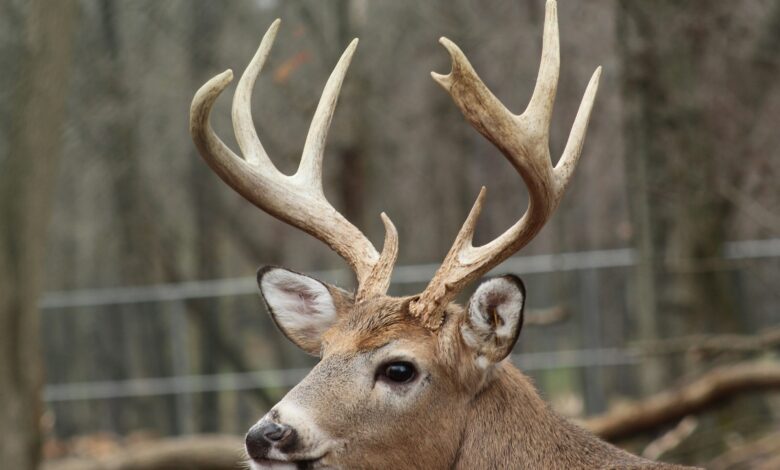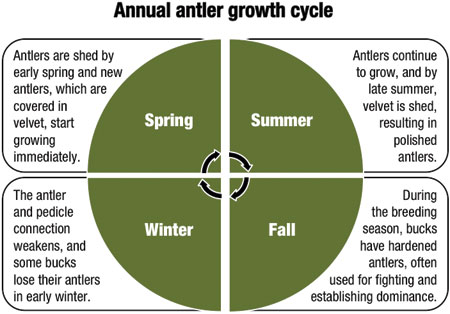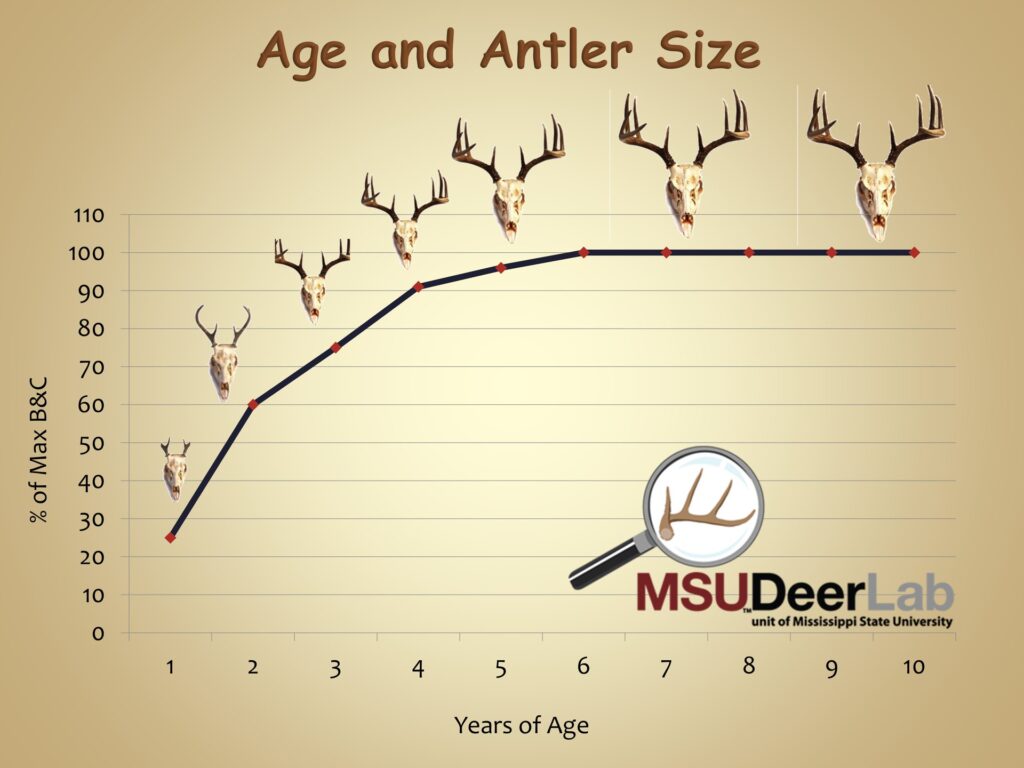Deer Antler Growth Chart by Month

Ever wondered what is it about antlers that gets the motor running for hunters?
While deer are magnificent animals, the antlers are the most engrossing aspect of their anatomy. Even after a decade of tracking them, I still marveled at bucks with a big set of antlers, fascinated by their beauty.
Unlike other forms of animal “headgear” like horns, deer shed antlers and regrow them every year. Interestingly, deer antlers go through three phases every year – growth, death, and casting.
If you are mystified by the annual rise and fall of deer antlers and their growth rate by month, this article is for you.
Understanding the Antler Growth Cycle
You may already know that deer tracks are unique. So are big buck antlers. Several factors influence the remarkable and complex growth of antlers. The primary factors are deer genetics, age, nutrition, and hormonal changes.
Male deer are not born with antlers and the base of the antler, called pedicle, starts forming on the skull when they are between four to seven months of age. The growth is fuelled by both the pituitary and testicular hormones.
Once the buck reaches its second year, the antler buds start to form on the pedicle. These antler bones are soft and spongy with almost 80% water content. That makes them more prone to damage and deformation.
Gradually they get covered by velvet- a type of skin different from the scalp skin. As the buck ages, the antler’s bones turn hard with marrows being formed on the inside. In time, the outer velvet dries out and is rubbed off by the buck.
This is not necessarily because the velvet causes some sort of irritation. In a full-grown antler, the cells in the velvet are dried and dead. That said, I have seen bucks trying to rub the velvet while the cells are still alive and bleed from it.
The antlers take around 5-6 years to reach full size. That means, to promote maximum antler size, protecting young bucks is a must.
Even when genetics are the same, the buck’s nutrition makes a huge difference in antler growth rate. Buck fawns require a higher level of protein in their diet for healthy antler growth compared to older fawns. Besides, minerals like calcium and phosphorus are directed from other bones in the body to promote antler growth.
As winter arrives, day length shortens and rutting activity drops, the blood supply to the antlers drops until they eventually fall off. The growth cycle starts repeating itself in April and May.

Deer Antler Growth Chart by Month
A deer antler size chart by month will tell you how the antler growth rate varies throughout the season.
March and April
In this early stage of antler growth, you will find 1-2 inches of growth on most bucks by mid-April. The growth rate is slow and depends on the amount of protein and minerals in their diet.
One reason behind the slow growth rate is that the length of the day is still on the shorter side and the hormonal flow has not reached its peak. Plus, harsh winters are stressful for deer and many might still be in recovery mode. Low availability of food, especially in the northern states, is also an issue.
May and June
With the food availability rising as summer approaches, the antler growth rate climbs up. As the antlers expand, the bone hardens and the velvet thickens. With the daylight hours reaching their peak by mid-June, there is enough hormonal support to accelerate the antler growth rate.
By the end of June, the main antler beam is fully developed and the primary points have started to grow. The ends of the antlers will have a slightly bulbous shape. Also, the velvet will start hardening at this stage.
July and August
The high growth rate continues in July and the points will be growing by mid-month. The growth rate can be incredibly high – elk antlers can grow close to an inch in a day. Deer can add as much as 65 pounds of bone tissue in these months of peak growth.
By July-end the antler growth is almost complete unless the process is hindered by drought or disease. This is also the period when bucks start shedding the dead layer of velvet.
Come August and the blood flow to the fully formed antlers comes down. The hardening of the bone tissue takes place in the next few weeks. The bucks also begin the polishing of the fully grown antlers. By rubbing them against the trees, they get rid of any remaining velvet.
September, October, and November
Antlers continue to harden as the deer rutting season draws closer and summer fades. By mid-September, the antlers are fully hardened and the velvet is shed. Through October and November, the antlers are used in battles and competing for mates.
December, January, and February
The rut concludes in December as the temperatures start to drop. With decreasing daylight, hormone levels drop and the deer prepare to shed their antlers, leaving the pedicle behind. While the exact shedding time varies, individual bucks tend to shed antlers at the same time every year. The reason is easy to guess – genetics.

Antler Growth Chart by Age
As the chart indicates, age and antler size are closely related. The prime years for the largest antler size vary between deer species. For whitetails, it is between 4 to 6 years.
For elks, it is between 9 to 12 years of age. Older males with heavier antlers tend to grow them slowly and even the casting date for such antlers is delayed.
Here is a closer look at how antler growth patterns vary with age for whitetails.
- One-year-old bucks have thin and short antlers that do not spread beyond their ears.
- Once a buck is two years old, expect the antlers to grow wider, showing the future potential for growth.
- At the age of three, a buck is between 50 and 75 percent of its antler-growth potential.
- Four-year-old males appear mature with fully developed necks and muscled shoulders. With the right nutrition, their antler growth potential can be between 80 and 90 percent.
- Between the ages of 5 and 7- the average age of a whitetail in the wild is about 6 years- deer touch their full antler growth potential. Data indicates that for an average whitetail, antler size does not change much after the age of 5.
- Most wild bucks above 8 years of age are past their prime and post-mature age. Their antlers will start showing signs of age-related degeneration.
Note that the age-specific antler characteristics vary due to various reasons and it is not unlikely for an older buck to have smaller antlers.
Final Thoughts
Here is the good news. Apart from knowing the standard deer hunting tricks, understanding the deer antler growth chart by month can help you become a better hunter.
If you prefer large antlers, it is your choice to let them develop by allowing the deer to grow a year older. I know hunters who encourage deer development in various ways.
That said, each deer is different and you cannot measure the antler growth rate with the same template. The buck who had four-point antlers last year may not become a six-point this year. So, while field judging buck age, look beyond the size of antlers.


